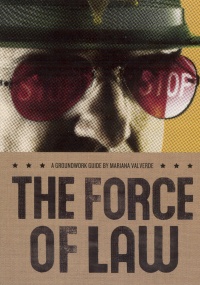| ________________
CM . . .
. Volume XVII Number 6. . . .October 8, 2010 
 |
The Force of Law. (Groundwork Guides).
Mariana Valverde.
Toronto, ON: Groundwood Books/House of Anansi Press, 2010.
144 pp., pbk. & hc., $11.00 (pbk.), $18.95 (hc.).
ISBN 978-0-88899-818-7 (pbk.), ISBN 978-0-88899-817-0 (hc.).
Subject Headings:
Law enforcement.
Law.
Police power.
Grades 9-12 / Ages 14-17.
Review by Greg Bak.
** /4
|
| |
|

excerpt:
The police called to a public housing development or to a shopping mall by a private security guard are unlikely to treat the person apprehended by a citizen's arrest as 'innocent until proven guilty' (a right of citizens in many democratic countries that puts the burden of proof on the prosecution in a criminal trial). Having an ongoing comradely relationship with their fellow uniformed forces of order, the police are unlikely to dispute the guard's version of events. The teenage shoplifter or the young man who made fun of the security guard are in a sense guilty before the police even arrive.
A picture is worth at least as many words as are in this book. The cover says it all. A cropped photo of an angry police officer, his sunglasses a demonic red, the word STOP floating over each eye. Below the picture screams the title: THE FORCE OF LAW.
Mariana Valverde spends the first third of her book discussing "the law" as a concept and how it translates into specific law codes, carefully making the distinction between law and justice. This is easily the best part of the book and could profitably serve as the basis for classroom debate. The remainder of the book takes a harshly critical look at the work of policing. Valverde's writing often seems rushed and not very careful, rife with bold assertions that lack sources or supporting evidence, as in the quotation above. What is her evidence that police officers routinely abuse the rights of citizens to favour their "ongoing comradely relationship" with mall cops and security guards? Though Valverde protests that civilians should be "innocent until proven guilty," she has no problem with sweeping assertions that police are uniformly secretive and corrupt.
The strangest aspect of Valverde's book is her repeated insistence that real life police work is nothing like that of movies and television – as though this would be news to any media-savvy teen. In particular, Valverde emphasizes that police work mostly consists of gathering, managing and sharing information about crimes, criminals and suspects. At times, she seems to suggest that the bureaucratization of police work is, itself, somehow suspect. But suspect of what? She seems scandalized that police officers take coffee breaks and talk with their co-workers. Why? Valverde's unsubstantiated insinuations are maddeningly vague and ultimately fruitless.
Valverde's writing is most convincing in those brief passages when she addresses the intersections of police, militias and American-led foreign policy in the global south. Citing her own experiences and those of other published researchers, Valverde sheds light on the poor choices afforded both civilians and police in impoverished or narcotic-producing regions. It is a shame that this fact-based analysis is awkwardly squeezed into what is primarily an impressionistic account of police work in the developed world.
Recommended with reservations.
Greg Bak is an archivist with Library and Archives Canada in Gatineau, PQ.

To comment
on this title or this review, send mail to cm@umanitoba.ca.
Copyright © the Manitoba Library Association. Reproduction for personal
use is permitted only if this copyright notice is maintained. Any
other reproduction is prohibited without permission.
NEXT REVIEW |
TABLE OF CONTENTS FOR THIS ISSUE
- October 8, 2010.
AUTHORS |
TITLES |
MEDIA REVIEWS |
PROFILES |
BACK ISSUES |
SEARCH |
CMARCHIVE |
HOME |
